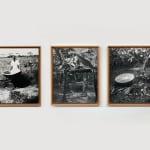Marcos Ávila-Forero France / Colombia, b. 1983
Estenopeicas de Paisajes Subversivos. Familia Vivas-Cabuyaro, 2015
Triptych, b/n positive of pinhole photographs, drawing, pinhole, video.
3 parts: 52 x 42 x 4 cm. each.
Edition of 5 plus 2 artist's proofs
Further images
Estenopeicas de paisajes subversivos (Pinhole photographs of subversive landscapes) is a exercise on memory restitution, focused on one of the main scenarios of such protests, with the collaboration of several...
Estenopeicas de paisajes subversivos (Pinhole photographs of subversive landscapes) is a exercise on memory restitution, focused on one of the main scenarios of such protests, with the collaboration of several peasant families from the ANUC —a historic organization that has been the target of repression, almost to the point of their total disappearance.
A group of houses belonging to peasant families linked to the organization —which have been and remain spaces for organization and social justice reclamations— were transformed into pinhole cameras (camara obscura) in order to shoot a series of photographic images. Thus, each house, by transforming into a huge photographic apparatus becomes a documentation tool that conveys the struggles of the peasants in order to preserve their territories.
The piece unfolds on triptychs, each matching three different points of view from the same home, portraying whatever is around: the mountainous landscape and the cultivated lands.
The proceedings of the camara obscura require a prolonged exposition time, causing the vanishing of the moving bodies and evoking historical archive images. This phenomenon can be read in a metaphorical way: as a spectre that stretches time, traveling along the history of said struggles from their origins till today.
Despite of the prolonged posing times, several peasants insisted in adding their physical presence to the images, transforming a project which —initially— only had been conceived in landscape terms. This fact creates a strong analogy between their intention to appear in the photograph — as a way to inscribe themselves in their territories— and the insistence of their struggles to safeguard the land.
A group of houses belonging to peasant families linked to the organization —which have been and remain spaces for organization and social justice reclamations— were transformed into pinhole cameras (camara obscura) in order to shoot a series of photographic images. Thus, each house, by transforming into a huge photographic apparatus becomes a documentation tool that conveys the struggles of the peasants in order to preserve their territories.
The piece unfolds on triptychs, each matching three different points of view from the same home, portraying whatever is around: the mountainous landscape and the cultivated lands.
The proceedings of the camara obscura require a prolonged exposition time, causing the vanishing of the moving bodies and evoking historical archive images. This phenomenon can be read in a metaphorical way: as a spectre that stretches time, traveling along the history of said struggles from their origins till today.
Despite of the prolonged posing times, several peasants insisted in adding their physical presence to the images, transforming a project which —initially— only had been conceived in landscape terms. This fact creates a strong analogy between their intention to appear in the photograph — as a way to inscribe themselves in their territories— and the insistence of their struggles to safeguard the land.












